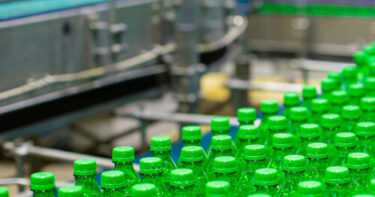
Table of Contents
- The Circular Transition
- Reduction & Elimination
- Improving Design
- Raising Recycling Rates
- Building End Markets
- Circularity: Next Steps
- How Anthesis Can Help
- Contact Us
Share this article
In recent months, major global corporations have been quietly backtracking on their public commitments towards addressing the waste and pollution crisis and delivering a circular economy for plastics. Petrochemical companies have abandoned plans to develop advanced recycling capabilities, beverage brands have stepped away from reusable & circular packaging objectives, and many others are withdrawing from voluntary initiatives in jurisdictions around the world.
Criticism has unsurprisingly followed on multiple fronts: activists are accusing brands of greenwashing, media outlets are holding brands to account for failure to deliver, and environmental advocacy organisations are lamenting the impact on developing much-needed collaborative solutions. Amid the inevitable crescendo of outrage that accompanies such actions in the digital age, it is worth taking a moment to reflect on progress in the seven years since the ‘Blue Planet effect’ started to shift global opinion about the impact of plastic waste and pollution on our world.
The Circular Transition: How We Got Here
Within the past couple decades, the confluence of climate change and environmental awareness with our increasingly connected and digital world gave communities and consumers increased opportunity to speak out against the environmental impacts of companies and businesses. As the volume of plastic waste piled up and the flow of plastic into our oceans grew exponentially, consumers were increasingly voicing their disgust to a global audience. With the contemporary amplification of social media and digital communication, the message carried far and wide, and the reputational damage to those brands most commonly identified in global pollution studies was keenly felt.
Highly exposed brands responded by going into damage control. They were forced to acknowledge and confront their contribution to the problem – the evidence was impossible to deny. But in reality, few had considered packaging within the remit of their broader sustainability initiatives – packaging was a ‘must have’, and plastic was cheap, efficient and, in the larger scheme of things, was thought to be relatively inconsequential.
That lack of understanding underpinned the establishment of voluntary initiatives in jurisdictions around the world to tackle the packaging and plastics circularity questions. Ahead of the curve, the Ellen MacArthur Foundation led the way in 2016, releasing the New Plastics Economy study and then, in 2018, signing up major global brand HQs to the Global Commitment. Signatories committed to a set of targets calibrated to deliver a circular economy for plastics. Localised initiatives soon emerged to support the delivery of aligned objectives at a jurisdictional level and voluntary initiatives like the Plastics Pact began to proliferate. In addition to focused reduction and elimination of problematic plastics, targets circulated around the key pillars of design, recycling, and end-markets, set to be delivered on by 2025.
Key Packaging Targets
- Upstream | Reduction & Elimination: Eliminate problematic and unnecessary single use plastics
- Upstream | Design: 100% of plastic packaging to be recyclable, reusable, or compostable
- Downstream | Recycling: 70% of plastic packaging is recycled
- Downstream | End Markets: 30% post-consumer recycled content in all new plastic packaging
It is variations on these targets from which many companies are now pulling away, but the reasons are many and varied and exist all along the circular plastics value chain.
Upstream | Reduction and Elimination
Without question, some progress has been made, particularly in jurisdictions where regulatory frameworks have supported the achievement of objectives. For example, the targeted elimination of problematic single use plastics has led to bans of plastic items such as drinking straws, cotton buds, lightweight shopping bags, and disposable food service packaging in multiple jurisdictions. Similarly, the use of Polyvinyl Chloride (PVC), which has recognised environmental impacts during production, but often also in disposal, has been virtually eliminated in many jurisdictions, with only a few medical applications remaining. Expanded Polystyrene (EPS), with its high propensity to become fugitive in the environment, is likewise targeted for phase out in many jurisdictions.
Conducting an Effective Packaging Baseline
Discover how an detailed packaging baseline can be leveraged to support packaging reduction and elimination goals.
Upstream | Design
The transition to recyclable, reusable, or compostable packaging has also been reasonably successful, but in some areas more than others. For example, significant material innovation has occurred in a relatively short space of time. Recyclability has been improved by design through the shift towards more recyclable polymers such as Polyethylene Terephthalate (PET) and other polyolefins, the reduction in the use of problematic dyes and pigments, and the shift towards soluble inks. Design has also been simplified to eliminate complex material constructions that present barriers to recycling, and to produce higher purity recycling outputs. Tethered bottle caps, for example, are now reducing the volume of closures that end up as litter.
While all this is positive, it assumes access to a recycling pathway for the material to enter in the first place. The truth is, in many places, this remains aspirational.
So, while recyclability by design has made significant gains at the upstream end of the circular plastics economy, it remains a somewhat one-sided achievement, particularly where the absence of collection, sortation, and recycling end markets for recovered material means that material is still likely to end up in non-circular disposal pathways – incineration, waste-to-energy, and landfill.
‘Theoretical’ recyclability is still no guarantee that the material will even be recovered, let alone recycled. And that’s not a scenario limited to emerging economies – mature economies also have gaps in downstream recovery and reprocessing capabilities with many legacy systems inadequately equipped to achieve the increasingly sophisticated levels of sortation and reprocessing required.
Another outcome of the design targets was to drive a shift towards reusable packaging, as opposed to recyclable. While much attention has been given to investigation into new business models, minimal change has been achieved on a global level. Despite wide acknowledgement that reusable systems must be consumer-centric and require standardisation, scale, and shared infrastructure to achieve genuine impact, many businesses continue to invest in small, time-bound, isolated trials and pilot programmes. Spawning the quote ‘more pilots than Heathrow’, these solo initiatives have often produced less-than-convincing outcomes, negatively impacting business confidence to make the switch.
Additionally, reuse models are often regarded as disruptors to the normal (i.e., highly optimised one-way patterns of retail business), so they are often placed outside the normal traffic flow in-store. This means that customers have to engage in new behaviours in order to create success. As a result, many trials do not attract consumers and are so time-limited that they can’t embed the necessary behaviour change required from consumers to embrace and continue purchasing in reusable packaging. While some markets have had a measure of success, reuse still only represents a small fraction of the packaging mix globally, despite the enormous impact it can deliver for material efficiency and circularity.
The world is looking to markets such as Germany – with its long-standing reusable beverage container systems – and France – with cross-category reusable packaging systems like Loop gaining traction – where reusable packaging is mandated by regulation, to see how it can be done.
And then there was compostable packaging – the silver bullet that was going to solve all our packaging waste problems. It looked great on paper, and all of a sudden, everything was being converted to compostable materials: shopping bags, mail satchels, food packaging, and more. It quickly became apparent, however, that we didn’t have access to the downstream composting systems we needed to process this material. Even if the capacity existed to process all of our organic waste in composting facilities, adding the immense volume of packaging materials circulating in the global economy into that mix would have eclipsed that balance very rapidly, leaving those materials with no better outcome than the materials they were replacing. While compostable packaging has found a niche in supporting the recovery of organic and food waste, it’s not quite been the saving solution that everyone was hoping for.
Downstream | Raising Recycling Rates
The target of achieving a 70% recycling rate for plastics by 2025 was a challenge from the outset, and the emergence of co-mingled recycling didn’t help. Even in the most well-equipped markets, overall recycling rates for packaging have been low and typically driven by the value in recovered fibre, metal, and glass. Plastic recycling rates languished around the now infamous 9% figure, primarily due to the poor quality and often highly contaminated nature of materials coming through the system, and a lack of sophisticated sortation capabilities to segregate the materials as required.
This was further exacerbated by a rapid shift to lightweight, flexible packaging, which was leveraged to capitalise on gains in relation to resource utilisation and supply chain emissions. Less material meant less weight and less space, resulting in lower emissions moving product to customer. Despite these benefits, the transition posed a significant obstacle for achieving the 70% recycling target, as an increasing volume of plastics entering the market were now constructed of complex and mixed materials, and were less recyclable than the materials they replaced.
Even if they were recovered, these materials offered little value for recyclers and struggled to find end markets. This became apparent with the collapse of Australia’s twelve-year-old Redcycle scheme in 2022. It was revealed that the front-of-store soft plastics recovery program had been stockpiling recovered materials, in the absence of a suitable end-market destination. Safety breaches resulting from this stockpiling led to the closure of the program and intervention from the Australian government to address the soft plastics challenge directly.
While designers have worked to eliminate complexity from the packaging landscape, gaps in downstream capacity have continued to pose problems in achieving circularity.
Still, a number of potential downstream solutions have emerged in recent years, and capacity building has been identified as key. Recovering more material volume and improving the sortation of plastic fractions can increase the quality and value of recycling feedstocks and drive efficiencies vital to ensuring system viability.
High specification material recovery facilities (MRFs) are a significant unlocker to improving material segregation. New technologies such as digital barcoding and robotic sortation have shown promise to dramatically enhance the identification and separation of plastic fractions and reduce contamination.
Unfortunately, new technology is expensive. In many jurisdictions, governments are focused on other priorities that take precedence over incentivising investment in waste management infrastructure. Meanwhile, public companies are typically focused on increasing shareholder wealth, making expensive voluntary investments in sustainable practices somewhat unpalatable.
Limitations in recycling systems globally have also posed a barrier to meeting the 70% recycled target. From an overall environmental perspective, mechanical recycling has been demonstrated through Life Cycle Assessment (LCA) to be a more favourable pathway for plastics, when compared with alternatives including incineration, waste-to-energy, or advanced recycling options. Many plastics in the market, however, require additional treatment prior to mechanical recycling to eliminate pigments and other materials that are added during plastic production. Furthermore, the highly bespoke and commercially sensitive nature of plastic production, and the myriad chemical compounds that may be used to meet a customer’s packaging requirements, make it challenging to demonstrate the removal of such additives when many recipes are regarded as corporate secrets by packaging converters.
This is likely to change in coming years, as increased scrutiny is placed on green chemistry and transparency within the plastics supply chain, but this opaqueness has resulted in much of the recovered plastic being downgraded into lower value applications or converted into entirely different products – for example, PET bottles being recycled into synthetic fabrics. Ironically, PET is the only mechanically recycled polymer that has been granted both EFSA and US FDA approval for use in high-value food grade applications, yet a significant portion of the recovered material is diverted to non-packaging uses.
Downstream | Building End Markets for Recycled Plastics
This leads conveniently to the final target of 30% recycled content in all plastic packaging. A significant quantity of the packaging placed on the market is to protect and deliver food and drink products safely to the consumer. We have seen that PET is currently the only mechanically recycled polymer that is approved for use in food-grade packaging but there is still a lot of food packaged in other polymers, most particularly rigid Polypropylene (PP) and High-Density Polyethylene (HDPE), and flexible Low-Density Polyethylene (LDPE). While these polymers can be mechanically recycled into packaging for non-food applications, such as personal or household care products and new pallet wrap, they are effectively excluded from use in high-grade food or near-food applications. This means that brand owners often have no option but to include 100% virgin material in food packaging, if they choose – often for very good reasons – to use a polymer other than PET.
Advanced recycling technologies offer an option, but these too face a range of challenges. Many of these technologies are capable of deconstructing plastics to their base polymers or even further into the precursor monomers. By eliminating all other compositional elements, the recovered materials are effectively ‘virgin-adjacent’ and suitable for reconstruction into new plastics for high-quality uses. Theoretically, this offers manufacturers the opportunity to incorporate this material into new packaging as a recycled content component, but hurdles exist. The cost of content produced through advanced recycling technologies is typically significantly higher than that of mechanically recycled content. This raises the cost of packaging significantly and, in a market where virgin material prices are significantly lower, there is little incentive for businesses to invest in this content, compromising the viability of the technology.
Additionally, it has been widely acknowledged that advance recycling technologies are energy intensive and can produce difficult-to-handle byproducts, dependent on the feedstocks used in the process. While these technologies have been promoted as a solution for hard-to-recycle materials (e.g., flexibles, mixed polymers, etc.), operators articulate a preference for clean, segregated materials targeting sources emerging from commercial and industrial sources, rather than post-consumer sources. In reality, most advanced recycling technologies have a significantly lower tolerance for the type of material emerging from the consumer goods sector, due both to contamination rates and complex construction, as with subsequently preference materials emerging from B2B sources, leaving post-consumer materials to downgraded applications.
The prohibitive cost has also been exacerbated by competition from the aviation industry, seeking to purchase the outputs from some advanced recycling processes to produce Sustainable Aviation Fuel (SAF). Diverting advanced recycling outputs to fuel severely restricts the forward circularity of those materials suitable for processing through these technologies. At the same time, this maintains a high price for the small volumes of material being produced, moving it out of reach for many packaging customers.
Adding another layer of confusion and uncertainty is the inconsistent approach to accounting processes for recycled content emerging from advanced technologies, and whether these materials are accepted by regulators in recycled content declarations. The variable acceptance of Mass Balance in reporting frameworks globally, combined with the higher cost of advanced recycling outputs, has resulted in many businesses deferring decisions – both around investment in recycling capacity and sourcing advanced recycled content – while awaiting clarity. While there are few limitations to utilising polymers from advanced recycling sources in virgin reduction initiatives, questions remain in some jurisdictions around its acceptance in recycled content declarations. The result being that while some capacity has emerged in recent years, with a number of developments springing up in Europe in particular, the lack of access, feedstock inconsistency, uncertainty around utility in recycled content declarations, and uncompetitive pricing have severely limited the uptake of advanced recycled content.
Signals from the fossil fuel industry in the past year, have further cast doubt on the viability of advanced recycling technologies as a solution to the plastics crisis. The quiet withdrawal of commitments to develop advanced recycling infrastructure from a number of major global petrochemical companies is perhaps a product of the lack of uptake on recycled materials emerging from these processes, particularly when the primary market for the virgin materials produced by many of these companies remains incredibly cheap and available to packaging users. It could also be argued that the unabated global appetite for fossil fuels and petrochemicals reduces the motivation for these companies to address improved recycling technologies. As long as that situation remains, a rapid transition to new technologies is unlikely to materialise any time soon.
Circularity: Where To From Here?
Many participants around the circular plastics value chain have done a lot since committing to targets, but all can and must do more. While few of these hurdles are insurmountable in achieving circularity, we are still stuck in a recycling mentality, because we feel that we understand what that looks like and we can probably envisage how to make it happen. But circularity remains something of an esoteric concept for many.
Three things have become very clear in the years since plastics targets were first proposed:
- The global landscape for plastics and plastic packaging is incredibly complex and there are myriad players contributing to that complexity in virtually every marketplace worldwide.
- Voluntary targets laid the foundations for circularity and are now giving way to mandatory measures, in response to the growing urgency of the issue. Without these voluntary commitments and close monitoring of progress towards those objectives, the evolution of the circularity dialogue would be have been significantly slower. While some targets may have not been delivered within the nominated timeframe, they have focused industry attention, helped to unpack the challenges to a profound level of understanding, and built a rich knowledge base that has benefited the entire global plastics value chain
- Removing the obstacles preventing the shift to plastics circularity is not the sole responsibility of one participant in the value chain. Collaboration is key, because all participants in the value chain have some role to fulfil in enabling the transition. Without action from all the players, the circle will never be closed.
Extended Producer Responsibility (EPR) and other incoming regulatory frameworks around the world will drive brands to fund this shift by ensuring that they are reducing and optimising packaging material use, exploring new and more economical delivery models, and covering the costs of recovery and recycling for the packaging materials they do place on the market.
Governments, however, must ensure that revenues from these regulatory models are appropriately ring-fenced and directed to support the capacity building needed to meet the demands of the market. This includes incentivising the development of advanced technologies to ensure high-grade plastics circularity is possible. While elimination by design will improve resource efficiency, plastics use is still predicted to grow, particularly in rapidly developing markets, as populations become more affluent and consumption increases.
Plastics producers and convertors must seek to incorporate more recycled or alternative materials in packaging, to build non-fossil-based end-market demand for sustainable content – including recycled plastics – and provide a degree of certainty to investors seeking to build capacity. Ensuring transparency on the content and construction of plastics, including those ingredients that are currently shielded by corporate secrets provisions, can also enable recyclers to understand exactly what they have in their hands and ensure that the materials are safe and suitable for new applications.
Exciting potential exists in the downstream side of the circle. Well-incentivised investment in new technologies, right along the downstream value chain, could ensure higher quality sortation, separation, and consolidation of purer material fractions, producing higher quality mechanically recycled plastics. Improvements in the deconstruction of materials, both through mechanical (delamination, deinking, etc.) and advanced reprocessing (pyrolysis, gasification, solvation, etc.), coupled with a clearer understanding of plastics compositions can facilitate more material being treated for high-quality mechanical recycling, while ensuring capacity exists for more advanced reprocessing of the balance.
Again, government has an important role to play in calibrating market settings to favour sustainable options.
It is the role of government to ensure that the carrots and the sticks are appropriately positioned to favour the sustainable outcome, and business will respond to price signals through the lens of profitability and the social licence to operate. As the cliché goes, ‘necessity is the mother of invention’.
An additional driver is the global focus on plastics through the Intergovernmental Negotiating Committee for an International Legally Binding Instrument (Treaty) to end plastic pollution, including in the marine environment. While the final scope of Treaty remains unclear, the agreement is likely to influence the global approach to this issue in coming years. Negotiations are on-going, but after INC-5(.1) in South Korea in November 2024 and INC 5.2 scheduled in Geneva in July 2025, a growing body of proactive UN Member States have amplified the call for a robust and enforceable accord that will address plastics from a whole lifecycle perspective, from extraction through to disposal. Unquestionably, the targets that emerged back in 2018, which reflect mitigation opportunities in the higher levels of the waste hierarchy, have provided a strong foundation for the shape of the draft treaty. It is hoped that the final instrument will continue with this holistic approach, to close gaps in the circle, and to ensure that all economies are adequately financed to facilitate the transition. And the reality is that once a Treaty is agreed, these types of voluntary, locally-calibrated targets may well be back on the table at a global level.
It is clear that responsibility for delivery of these targets lies across a complex network of players, and no one link in the chain can solve the whole problem. For businesses that have committed to targets they find themselves unable to deliver, it is fair to say that while progress has been made, some responsibility continues to lie with them, to continue improving system inputs and becoming a customer for the recycled outputs. But as discussed, all the participants in the circular value chain, and the governments that shape the circular economy landscape, have work to do to build the foundations that will deliver plastics circularity. And given what’s on the horizon from a regulatory perspective, dropping the ball entirely may not be in the best interests for businesses this far along the path.
How Anthesis Can Help
Anthesis understands the reputational impact that this type of exposure can have, with both your customers and your stakeholders. We can help you to understand the hotspots where internal action can bring you closer to meeting your existing targets and how long that might take; we can help you to celebrate the achievements that your business has made towards target objective, but also help articulate the story behind those hurdles that are beyond your control. If you’re business is feeling the heat from your target commitments, our Packaging and Purpose teams are at your disposal, and we would welcome the opportunity to support you through the process of managing your target reset.
Packaging Targets & Public Commitment Strategy
We support businesses in building strategy to address and manage packaging related commitments and targets through exposure review, target realignment, and identification of drivers and barriers.
Our approach consists of:
- Target Review: Reviewing and aligning existing packaging commitments across the business, and conducting a horizon scan in relevant jurisdictions for future circularity policy, infrastructure developments, and potential obstacles to target delivery.
- Ideation: Facilitating a collaborative and focused workshop with key internal stakeholders – guided by Anthesis’ expertise – to identify priorities and opportunities for “off-track” commitments.
- Strategic Direction: Providing detailed recommendations for business actions and communication opportunities based on existing commitments, their current status and obstacles to delivery, and workshop findings.
- Telling the Story: Developing targeted internal and external communication strategies that are relevant to each commitment, celebrating successes and addressing the risk factors identified.
Many companies have struggled, often due to barriers outside their control, to deliver on their packaging targets – and exposed businesses are finding themselves managing reputational risk. Anthesis can support you in building a tailored strategy for addressing this risk and taking the next steps in delivering on your packaging commitments.
Explore Our Packaging Services
Our team of experts advise global organisations across the packaging value chain, including retailers, manufacturers, brand owners, associations, and NGOs. We specialise in helping clients navigate the balance between the functional and economic needs of their packaging while responding to the evolving sustainability landscape.
We are the world’s leading purpose driven, digitally enabled, science-based activator. And always welcome inquiries and partnerships to drive positive change together.



